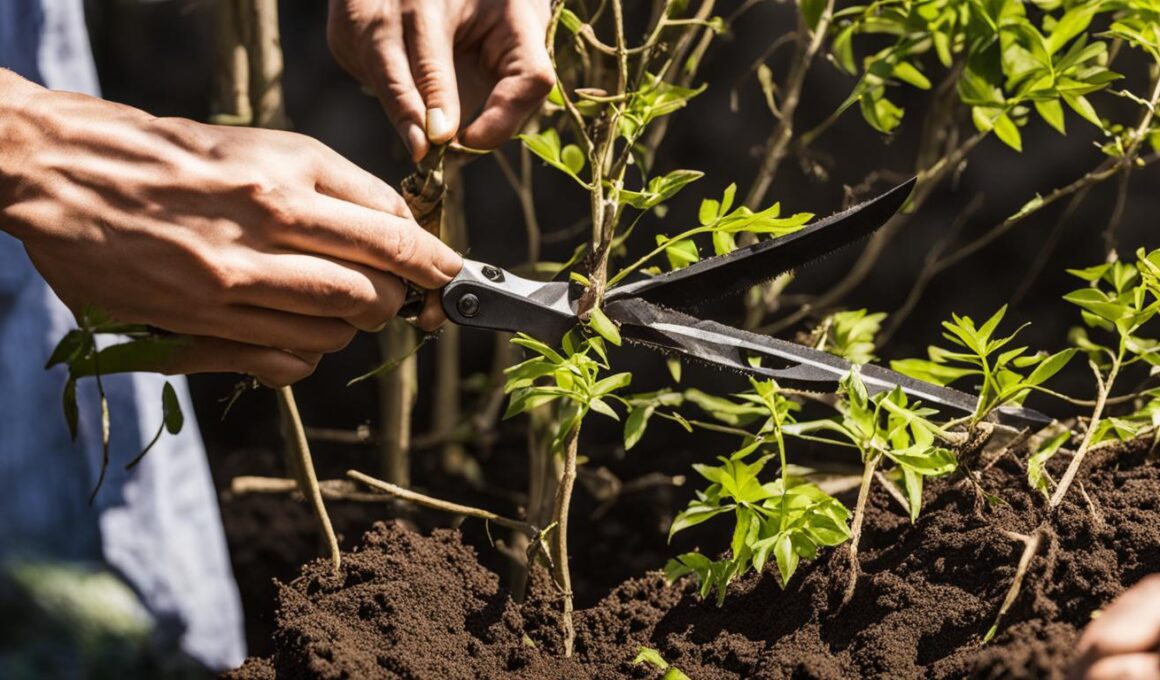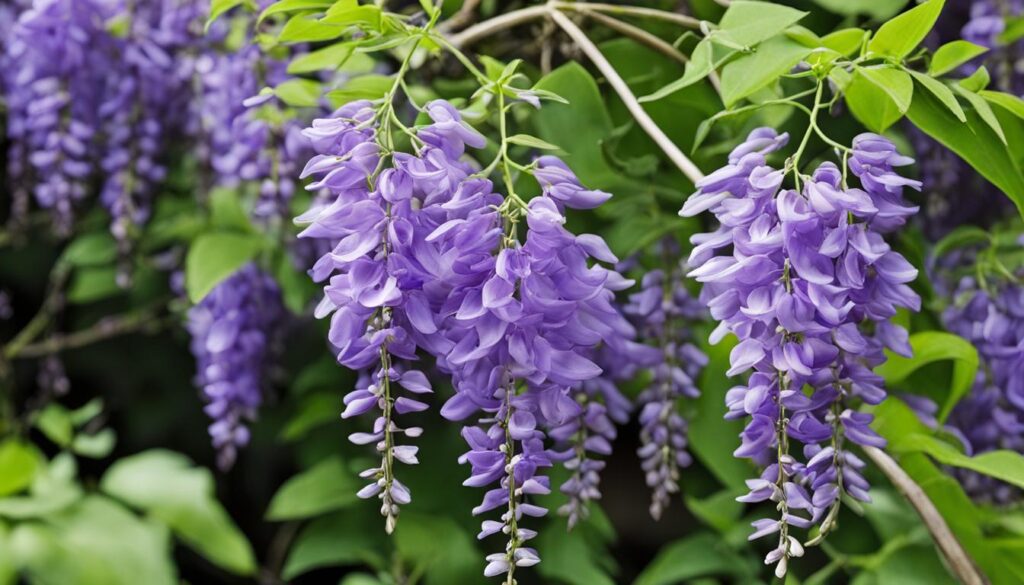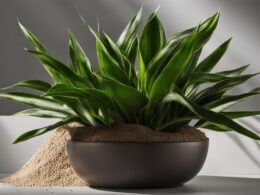Welcome to our guide on propagating wisteria! If you’ve ever admired the stunning beauty of wisteria and wished you had more of these graceful vines in your garden, you’re in luck. Propagating wisteria from cuttings is a straightforward process that allows you to grow new wisteria plants from existing ones. In this article, we will share valuable wisteria propagation tips to help you successfully propagate wisteria and enjoy the abundance of its gorgeous blooms.
One of the easiest ways to propagate wisteria is by taking cuttings. These cuttings can be sourced from leftover prunings or specifically prepared for growing wisteria from cuttings. For successful propagation, choose cuttings that are approximately 3 to 6 inches long and taken from the softwood (green) part of the plant. The lower half of the cutting should be free from any leaves, and the bottom trimmed to ensure the lowest node is positioned about 1/2 to 1/4 inch from the base.
To encourage root development, dip the cutting in rooting hormone before planting it in a well-draining potting soil. The pot should be covered with plastic to increase humidity and placed in a location with bright, indirect light. Over a period of four to six weeks, the cuttings will develop roots, and you can then transplant them into your garden.
In the following sections, we will provide you with specific wisteria propagation tips to ensure your success, including cutting preparation, choice of rooting hormone and potting soil, as well as care for the newly transplanted wisteria cuttings. We will also guide you in choosing the right wisteria species for your desired structure, such as pergolas, walls, or containers. Let’s get started on your journey to growing beautiful wisteria plants!
Tips for Propagating Wisteria Cuttings
When it comes to propagating wisteria cuttings, proper preparation is essential for success. Follow these tips to ensure your wisteria cuttings have the best chance to root and thrive:
- Start by removing the sets of leaves on the lower half of the cutting. These nodes are where new roots will develop, so it’s important to clear any foliage that may hinder root growth.
- Trim the cutting so that the lowest node is about 1/2 to 1/4 inch from the bottom. This ensures that there is enough stem for planting while allowing the cutting to focus its energy on root development.
- If your cutting has any flower buds, it’s advisable to remove them. While flowers are beautiful, they can divert the energy away from root development, delaying or reducing the chances of successful propagation.
- Dip the cutting in rooting hormone to encourage root formation. Rooting hormone contains growth-promoting substances that stimulate root growth, increasing the chances of successful rooting.
- Choose a potting soil specifically formulated for cuttings or create a well-draining mixture by combining equal parts perlite, peat moss, and vermiculite. Moisten the soil before planting the cutting to ensure it maintains the right moisture levels.
- Plant the wisteria cutting in the prepared pot, making sure the plastic covering does not touch the cuttings. This prevents rot and allows proper air circulation.
- Place the pot in a location with bright, indirect light. Wisteria cuttings require sunlight for photosynthesis, but direct sunlight can be too intense and potentially damage the delicate roots.
- Check the moisture levels of the soil regularly and water when it feels dry to the touch. Overwatering can lead to rot, while underwatering can hinder root development. Strive for a balanced moisture level, keeping the soil consistently moist but not waterlogged.
Your patience will be rewarded! In approximately four to six weeks, you should begin to see roots forming on your wisteria cuttings. At this point, they are ready to be transplanted into larger pots or directly into your garden, continuing their journey to becoming beautiful, mature wisteria plants.
Choosing the Right Wisteria for Propagation
When it comes to propagating wisteria, it’s essential to choose the right species for your intended purpose. There are several wisteria species commonly used for propagation, including Wisteria floribunda, Wisteria sinensis, and Wisteria brachybotrys.
- Japanese wisteria (Wisteria floribunda): Known for its long flower racemes, Japanese wisteria is a stunning choice for growing on pergolas or arches. The elegant hanging flowers create a captivating display that will add charm to any outdoor space.
- Chinese wisteria (Wisteria sinensis): If you’re looking to grow wisteria against a wall, Chinese wisteria is the perfect match. This species flowers before the leaves appear, filling the wall with a beautiful burst of color.
- Silky wisteria (Wisteria brachybotrys): With its downy leaves and short racemes, silky wisteria is a versatile species that can be grown on both walls and pergolas. Its unique charm will enhance any vertical structure in your garden.
- Wisteria frutescens ‘Amethyst Falls’: If you prefer to grow wisteria in a container, look for compact varieties such as Wisteria frutescens ‘Amethyst Falls.’ These smaller-sized wisteria plants are perfect for adding a touch of beauty to your patio or balcony.
By selecting the right wisteria species based on your desired structure, whether it’s a pergola, wall, or container, you can ensure optimal growth and visual appeal. Remember to provide the necessary care and maintenance to help your wisteria thrives and flourishes.
Conclusion
Propagating wisteria from cuttings is a simple and effective way to increase your wisteria collection. By following the proper steps, such as taking cuttings from softwood, using rooting hormone, and providing the right care, you can successfully root wisteria plants.
Choosing the right wisteria species for your desired structure, whether it’s a pergola, wall, or container, is essential for achieving wisteria propagation success. Japanese wisteria (Wisteria floribunda) with its long flower racemes is perfect for hanging down from a pergola or arch. Chinese wisteria (Wisteria sinensis) is ideal for planting against a wall since it flowers before the leaves appear. Silky wisteria (Wisteria brachybotrys) with its downy leaves and short racemes can thrive on walls or pergolas. Compact varieties like Wisteria frutescens ‘Amethyst Falls’ are great choices for growing wisteria in containers.
With the right techniques and proper care, you can enjoy the beauty of lush wisteria blooms in your garden. Take the time to propagate wisteria from cuttings, and your efforts will be rewarded with a stunning display of cascading flowers and a garden filled with the enchanting fragrance of wisteria.
Is the Propagation Process Similar for Wisteria and Japanese Maple?
Yes, the propagation process for wisteria and Japanese maple trees is quite different, especially when it comes to propagating Japanese maple trees. Wisteria can be propagated through seeds or cuttings, while Japanese maple trees are typically propagated through grafting or air-layering techniques.










